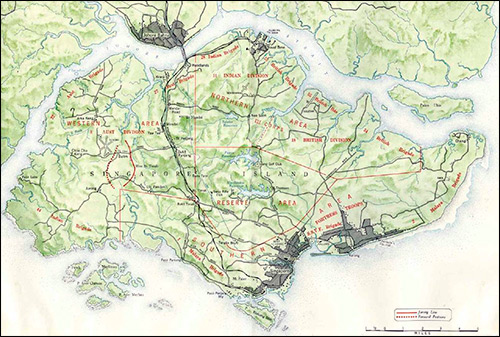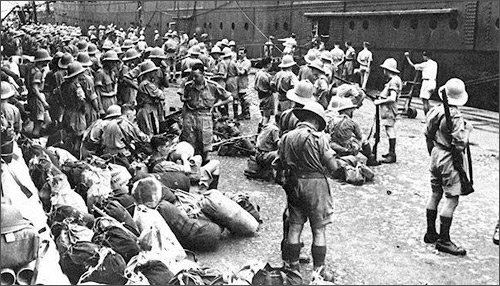

Singapore
Singapore with its large docks and naval base was thought by many to be an "Impregnable Fortress". Defended by heavy 15-inch naval guns stationed at Fort Siloso, Fort Canning and Labrador, it was considered to be a strategically vital military base in the protection of British Commonwealth Interests in the Far East and was also one of the most important ports in the world.
It was joined to mainland Malaya by the Johore Causeway, a landbridge crossing the narrow Strait of Johore.

Map of Singapore Island - 1942
The troopship USS Mount Vernon carrying the Royal Norfolks and Cambridgeshire Regiments had a head start on the rest of their former convoy (still anchored off Bombay) and by 13th January 1942 had arrived at the naval base in Singapore, under heavy bombing from the Japanese airforce.
The troops were hurriedly disembarked and dispersed to temporary billets. It would not be very long before they would be called into combat with the advancing Japanese but they were lacking in transport and weapons most of which was still on board the convoy following on from Bombay.
Unloading of the ship's cargo proceeded as rapidly as possible but had to be interrupted on several occasions as bombers continued to target the docks. As soon as the troops had disembarked she immediately began embarking civilian passengers waiting to flee the beleaguered island and by mid afternoon the following day she got under way with her two escorts HMS Juma and HMS Jupiter bound for Aden via the relative safety of the Indian Ocean.

Troops arriving at Singapore Harbour
The Japanese continued their rapid advance south through the Malay Peninsula, never allowing the Allied forces time to re-group. The defences in Malaya were being overrun and the troops there were being forced into a retreat. The Allies had no tanks to help in their defence which put them at a severe disadvantage. The brutality of the Japanese soldiers was already evident since no prisoners were being taken and even the wounded were murdered where they lay.
The British were led by Lieutenant General Arthur Percival who had been convinced that the Japanese would only attack from the sea, (believing that the Malay jungle was impassable). He now had to regroup the forces under his command for the defence of Singapore Island.
Just over two weeks later on the 29th January the USS West Point, USS Wakefield and Empress of India carrying the 54th and 55th Infantry Brigade left Convoy CT 11 and proceeded via the Berthala Straits to Singapore. The Naval base was now under constant attack from the Japanese so it was decided to unload the troops and cargo at the commercial docks at Keppel Harbour. Immediately on arrival they began unloading their cargo and the thousands of troops onboard began disembarking. By the end of the day all but a few hundred Royal Engineers remained on board.
Sadly the arrival of the 54th and 55th Divisions was too late to save Singapore. To make matters worse, they arrived only carrying small arms since their transport, ordnance and heavy equipment was on vessels still at sea and many days away from port.
The following day January 30th, Japanese bombers arrived over the harbour area and the USS Wakefield took a direct hit killing five men and injuring many more. Along with the USS West Point she had been embarking a large British contingent of civilians, dockyard and naval personnel and their families who were being evacuated from the doomed island.
By late afternoon that day the two American vessels left Singapore bound for Bombay and Aden. Many more civilians were boarded on the Duchess of Bedford and Empire Star which left shortly after, leaving a scene of devastation and burning buildings behind them.
General Percival now realised that the allied defences in Malaya could not halt the advancing Japanese troops so he ordered them to fall back over the Johor Causeway to where they would make a last stand in the defence of Singapore Island. As the last of the troops retreated on 31st January they blew up the railway line and the road behind them, delaying the Japanese attack for nine days.
On February 8th, 1942, the Japanese crossed the Johor Strait for the final assault on Singapore. Prior to this attack, they had intensified their bombardment of the eastern side of the island leading Percival to spread his men across the entire northern and eastern coastline of the island but this diversionary tactic kept many of the allied soldiers away from the main Japanese attack force in the north west channel.
On February 10th General Wavell, the British commander in the region received a message from Churchill urging the troops in Singapore to fight on - "There must at this stage be no thought of saving the troops or sparing the population. The battle must be fought to the bitter end at all costs. The 18th Division has a chance to make its name in history. Commanders and senior officers should die with their troops. The honour of the British Empire and of the British Army is at stake."
The Japanese advanced rapidly and by February 11th had captured the Bukit Timah area, including most of the allied ammunition and fuel and giving them control of the main water supply. Fierce fighting continued and in some areas of the island allied troops managed to hold the Japanese advance but by the morning of 15th February, the Japanese had broken through the last line of defence and the Allies were fast running out of supplies and ammunition.
Percival held a meeting with senior commanders to discuss their plight. It was clear that if they launched a counter attack it would be a fight to the death for his troops. Still unaware of the fighting strength of the enemy and with the dead lying around in thousands Percival opted for surrender. He ordered a cease-fire and arranged a meeting with Japanese commanders later that day.
At the Ford Motor Factory at Bukit Timah, Percival and the Japanese commanding officer Lt Gen Yamashita met to discuss terms of surrender. By 5.15 p.m. that day Percival had agreed an unconditional surrender of all military forces (Army, Navy and Air Force) in the Singapore Area. Shortly after, all allied soldiers were ordered to lay down their arms.
Roy remembered those final days:
Just before the capitulation, the Empress of Asia sailed into Singapore with the Northumberland fusiliers on board. Unfortunately the ship was sunk and everyone swam ashore, what a tragic ending, travelling half way round the world to be taken prisoner.
Two days before the capitulation we left all our trucks and dug in trenches near the Polo ground. We could tell by the pause between the gunfire and the mortar fire that the Japanese were only a short distance away.
We thought that street fighting was imminent but on 15th Feb.1942 we got a visit from a high ranking British officer telling us that General Percival had agreed to a capitulation which of course meant that hostilities had ceased.
Later Yamashita reportedly said: "My attack on Singapore was a bluff – a bluff that worked. I had 30,000 men and was outnumbered more than three to one. I knew that if I had to fight for long for Singapore, I would be beaten. That is why the surrender had to be at once. I was very frightened all the time that the British would discover our numerical weakness and lack of supplies and force me into disastrous street fighting."
General Percival had vastly overestimated the strength of the opposing Japanese units. His view was that Yamashita's forces were far stronger numerically, believing them to have about 100,000 troops. In reality they had only around 30,000 and were very low in supplies and ammunition.
A synopsis of the Fall of Singapore is shown in the video below :
Churchill described the loss of Singapore as “The greatest disaster and capitulation in British history.”
The reasons behind this military disaster have long been the subject of discussion by military experts and laymen alike. The fact that the Allies were virtually without any credible air support coupled with the fact they had no tanks to support the infantry all did nothing to help their cause.
However, the battle was already lost well before the thousands of men from the 18th Division were diverted from Bombay and Mombassa. In just two weeks after landing on the docks at Singapore they were ordered to surrender.
As a result of the surrender the Japanese took over 90,000 men prisoner in Singapore. Many would never return home.
